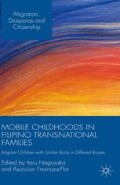Abstract
The Philippines has been a major source of international migrants since the 1970s. The Commission on Filipinos Overseas estimates that, by the end of 2012, a total of 10,489,628 Filipinos, or about 10 per cent of the country’s population, were living and working in over 200 countries (CFO, 2013).
Access this chapter
Tax calculation will be finalised at checkout
Purchases are for personal use only
Preview
Unable to display preview. Download preview PDF.
References
Aguilar, F. V. (2009). Maalwang Buhay: Family, overseas migration, and cultures of relatedness in Barangay Paraiso. Quezon City: Ateneo de Manila University Press.
Alegado, D. T. (1992). The political economy of international labor migration from the Philippines. Unpublished doctoral dissertation, University of Hawai’i, Honolulu.
Asis, M. M. B. (2006). Living with migration: Experiences of left-behind children in the Philippines. Asian Population Studies, 2 (1), 45–67.
Barber, P. (2000). Agency in Philippine women’s labour migration and provisional diaspora. Women’s Studies Internal Forum, 23 (4), 399–411.
Battistella, G., & Conaco, C. (1998). Impact of labor migration on the children left behind: A study of elementary school children in the Philippines. Sojourn, 13 (2), 220–241.
Castles, S., & Miller, M. J. (2009). The age of migration: International population movements in the modern world ( 4th ed. ). London: Macmillan.
Clifford, J. (1997). Routes: Travel and translation in the late twentieth century. Cambridge, MA: Harvard University Press.
Commission of Filipinos Overseas [CFO]. (n.d.). Number of registered Filipino emigrants by country of destination and age group (13–19): 1988–2012. (Unpublished statistics).
Commission of Filipinos Overseas [CFO]. (2013). Stock estimate of overseas Filipinos as of December 2012. Retrieved August 11, 2014, from http://www.cfo.gov.ph/images/stories/pdf/StockEstimate2012.pdf.
Commission of Filipinos Overseas [CFO]. (2014a). Number of registered Filipino emigrants by age: 1981–2013. Retrieved August 11, 2014, from http://www.cfo.gov.ph/images/stories/pdf/by_age2013.pdf.
Commission of Filipinos Overseas [CFO]. (2014b). Number of registered Filipino emigrants by major country of destination: 1981–2013. Retrieved December 13, 2014, from http://www.cfo.gov.ph/images/stories/pdf/bymajorcountry2013.pdf.
Commission of Filipinos Overseas [CFO]. (2014c). Number of Filipino spouses and other partners of foreign nationals by major country: 1989–2013. Retrieved December 13, 2014 from http://www.cfo.gov.ph/images/stories/pdf/majorcountry8913a.pdf.
Commission of Filipinos Overseas [CFO]. (2014d). Number of Filipino spouses and other partners of foreign nationals by sex: 1989–2013. Retrieved December 13, 2014 from http://www.cfo.gov.ph/images/stories/pdf/gender8913.pdf.
Cruz, V. (1987). Seasonal orphans and solo parents: The impact of overseas migration. Quezon City: Scalabrini Migration Center.
Espiritu, Y. L. (2001). ‘We don’t sleep around like white girls do’: Family, culture, and gender in Filipina American lives. Signs, 26(6), 415–440.
Espiritu, Y. L. (2003). Home bound: Filipino American lives across cultures, communities, and countries. Berkeley, CA: University of California Press.
Espiritu, Y. L. (2009). Emotions, sex, and money: The lives of Filipino children of immigrants. In N. Foner (Ed.), Across generations: Immigrant families in America (pp. 47–71 ). New York: New York University Press.
Espiritu, Y. L., & Wolf, D. (2001). The paradox of assimilation: Children of Filipino immigrants in San Diego. In R. G. Rumbaut & A. Portes (Eds.), Ethnicities: Children of immigrants in America (pp. 157–186 ). Berkeley, CA and Los Angeles, CA: University of California Press.
Fresnoza-Flot, A. (2009). Migration status and transnational mothering: The case of Filipino migrants in France. Global Networks, 9 (2), 252–270.
Guevarra, A. R. (2009). Marketing dreams, manufacturing heroes: The transnational labor brokering of Filipino workers. New Brunswick, NJ: Rutgers University Press.
Hau, C. S. (2004). On the subject of the nation: Filipino writings from the margins 1981 to 2004. Quezon City: Ateneo de Manila University Press.
Liu, J. M., Ong, P. M., & Rosenstein, C. (1991). Dual chain migration: Post-1965 Filipino immigration to the United States. International Migration Review, 25 (3), 487–513.
Nagasaka, I. (2009). Kokkyo wo Koeru Firipin Murabito no Minzokushi: Toransunasyonarizumu no Jinruigaku [Ethnography of Filipino transnational villagers: Anthropology of transnationalism]. Tokyo: Akashi.
National Statistics Office [NSO]. (1997). Philippine year book. Manila: National Statistics Office.
Okamura, J. (1998). Imagining the Filipino American diaspora: Transnational relations, identities, and communities. New York: Garland Publishing, Inc.
Parreiïas, R. S. (2001). Servants of globalization: Women, migration and domestic work. Stanford, CA: Stanford University Press.
Parreiïas, R. S. (2005). Children of global migration: Transnational families and gendered woes. Stanford, CA: Stanford University Press.
Philippine Overseas Employment Administration [POEA]. (2014). Compendium of OFW statistics. Retrieved January 12, 2015 from http://www.poea.gov.ph/stats/2013_stats.pdf.
Pratt, G. (2012). Families apart: Migrant mothers and the conflicts of labor and love. Minneapolis, MN and London: University of Minnesota Press.
Suzuki, N. (2010). Outlawed children: Japanese Filipino children, legal defiance, and ambivalent citizenships. Pacific Affairs, 83 (1), 31–50.
Takahata, S. (2015). ‘From the Philippines to Japan: Marriage migrants and new Nikkei Filipinos’. In Y. Ishikawa (Ed.), International migrants in Japan: Contributions in an era of population decline (pp. 97–122 ). Kyoto: Kyoto University Press.
Tyner, J. A. (2009). The Philippines: Mobilities, identities, globalization. New York: Routledge.
Wolf, D. (2002). “There’s no place like home”: Emotional transnationalism and the struggles of second generation Filipinos. In P. Levitt & M. Waters (Eds.), The changing face of home: The transnational lives of the second generation (pp. 255–294 ). New York: Russell Sage Foundation.
Editor information
Editors and Affiliations
Copyright information
© 2015 Itaru Nagasaka
About this chapter
Cite this chapter
Nagasaka, I. (2015). Migration Trends of Filipino Children. In: Nagasaka, I., Fresnoza-Flot, A. (eds) Mobile Childhoods in Filipino Transnational Families. Migration, Diasporas and Citizenship Series. Palgrave Macmillan, London. https://doi.org/10.1057/9781137515148_3
Download citation
DOI: https://doi.org/10.1057/9781137515148_3
Publisher Name: Palgrave Macmillan, London
Print ISBN: 978-1-349-56682-2
Online ISBN: 978-1-137-51514-8
eBook Packages: Palgrave Social Sciences CollectionSocial Sciences (R0)

